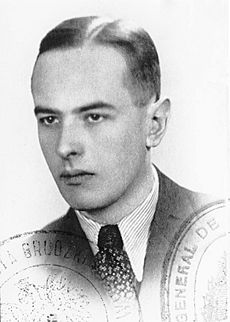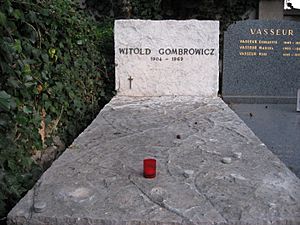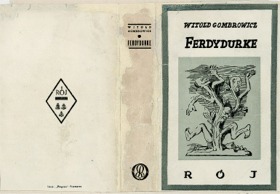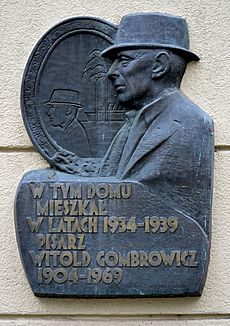Witold Gombrowicz facts for kids
Quick facts for kids
Witold Gombrowicz
|
|
|---|---|
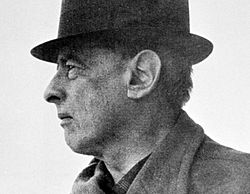 |
|
| Born | Witold Marian Gombrowicz August 4, 1904 Małoszyce, Congress Poland, Russian Empire |
| Died | July 24, 1969 (aged 64) Vence, France |
| Occupation | Novelist, dramatist, diarist |
| Language | Polish |
| Nationality | Polish |
| Alma mater | University of Warsaw (MJur, 1927) |
| Notable works | Ferdydurke Trans-Atlantyk Kosmos The Marriage |
| Website | |
| witoldgombrowicz.com | |
Witold Marian Gombrowicz (born August 4, 1904 – died July 24, 1969) was a famous Polish writer and playwright. He wrote stories and plays that looked deeply into how people think and feel. His works often showed strange or funny situations, and he liked to question common ideas about national pride.
In 1937, he published his first novel, Ferdydurke. This book explored many of his favorite topics. It talked about growing up, how people create their own identity when they interact with others, and it made fun of different social groups in Polish society and culture.
Gombrowicz became well-known only later in his life. Today, he is seen as one of the most important writers in Polish literature. His personal Diaries, published in 1969, are considered a masterpiece by many. His novel Cosmos is also highly praised. He was nominated for the Nobel Prize in Literature four times between 1966 and 1969.
Contents
Life Story
Early Years in Poland
Witold Gombrowicz was born in Małoszyce, a small town near Opatów in what was then part of the Russian Empire. His family was wealthy and belonged to the gentry, a class of landowners. He was the youngest of four children.
In 1911, his family moved to Warsaw. After finishing high school in 1922, Gombrowicz studied law at Warsaw University. He earned his law degree in 1927. He then spent a year in Paris, France, studying international relations. He didn't study very hard there, but he met many other young thinkers. He also traveled around the Mediterranean Sea.
When Gombrowicz returned to Poland, he tried to find a job in law but didn't have much luck. In the 1920s, he started writing. He began with short stories, which were later collected and published as Memoirs of a Time of Immaturity. This book was later renamed Bacacay. He also started writing reviews and articles for newspapers. He met other young writers in Warsaw's cafes. The publication of Ferdydurke, his first novel, made him famous in literary circles.
Life in Argentina
Just before World War II started, Gombrowicz traveled to South America on a Polish ship. When he heard that war had broken out in Europe, he decided to stay in Buenos Aires, Argentina, until the war ended. He remained in Argentina until 1963, often living in poverty, especially during the war years.
In the late 1940s, Gombrowicz tried to become known in Argentina. He published articles and gave lectures. In 1947, a Spanish translation of Ferdydurke was published with the help of his friends. This version is now seen as very important for Argentine literature. However, at the time, it didn't make him widely famous.
From 1947 to 1955, Gombrowicz worked as a bank clerk. During this time, he became friends with Zofia Chądzyńska, who helped him meet important people in Buenos Aires. In 1951, he started publishing parts of his Dziennik (Diaries) in a Polish journal in Paris. In 1953, he published a book that included his play Ślub (The Marriage) and the novel Trans-Atlantyk. This novel talked about what it means to be Polish when living in another country. After 1956, four of his books were published in Poland, which made him very well-known there.
Last Years in Europe
In the 1960s, Gombrowicz became famous around the world. Many of his works were translated into other languages. His plays were performed in theaters in France, Germany, and Sweden.
In 1963, Gombrowicz received a scholarship and returned to Europe. He first stayed in West Berlin for a year. His health got worse during this time, so he couldn't go back to Argentina. In 1964, he moved to France. He met Rita Labrosse, a Canadian student, who became his secretary. He spent the rest of his life in Vence, a town near Nice in the south of France.
Gombrowicz's health prevented him from fully enjoying his late fame. He became very ill in 1964 and could barely write. In 1967, he won an important international award. In 1968, he married Rita Labrosse. To cheer him up, his friend Dominique de Roux asked him to give a series of lectures on philosophy. Gombrowicz called them "Guide to Philosophy in Six Hours and Fifteen Minutes." He talked about thinkers like Kant and existentialism. He died on July 24, 1969, before he could finish the lectures. He was buried in the cemetery in Vence.
His Writing
Gombrowicz wrote in Polish. He did not allow his most important work, his Diaries, to be published in Poland until the government lifted a ban on the full version. Because of this, many people in Poland didn't know his work until the 1970s. However, his books were printed in Polish by a publisher in Paris and translated into more than 30 languages. His plays were also performed by famous directors around the world.
Gombrowicz's writing often shows how people get tangled up in each other's thoughts and feelings. He also explored the problems that happen when old traditions clash with new ideas. His writing often had a funny, yet frustrating, sense of the absurd. He used clear and sharp language to criticize traditional Polish ideas, especially those from the Romantic period. He even said he wrote to challenge famous Polish poet Adam Mickiewicz.
Gombrowicz's work is connected to ideas like existentialism, which explores freedom and responsibility, and structuralism, which looks at patterns in human thought. He also used playful hints and satire in his writing. For example, a part of Trans-Atlantyk is written like an old diary, followed by a funny copy of a traditional fable.
Many experts find Gombrowicz's work interesting because it connects with modern European thought. He used a first-person point of view in most of his novels. He also made up new words, or "keywords," that helped explain the deeper meaning behind his ironic stories. For example, in Ferdydurke, he used gęba (meaning a "face" or a false personality someone puts on) and pupa (meaning to make someone feel childish or immature).
In Ferdydurke, Gombrowicz talks about "form" as a way that society and other people can control an individual. The novel can be read as a satire, making fun of different Polish groups. It shows people either as part of a group or as individuals struggling with themselves and the world.
Many theaters performed plays based on Ferdydurke and his other works, especially before 1986. This was often the only way for people to experience his work officially in Poland.
Gombrowicz's first play was Iwona, księżniczka Burgunda (Ivona, Princess of Burgundia), written in 1938. It's a tragicomedy that shows what happens when people are trapped by rules, customs, and ceremonies.
In 1939, he published a popular novel called Opętani (Possessed) in daily newspapers. It mixed old-fashioned Gothic novel elements with modern adventure.
His play Ślub (The Marriage), written after the war, used ideas from Shakespeare's plays. It also looked at how power works and how people are shaped by others.
In Trans-Atlantyk, Gombrowicz compares the old idea of people serving values with a new idea of individuals freeing themselves.
Kosmos (Cosmos) is one of Gombrowicz's most complex books. It explores how humans create their understanding of the world and how stories themselves create meaning.
Operetka (Operetta), his last play, uses the style of an operetta to make fun of 20th-century totalitarianism, which is when governments have total control. But it also shows a small hope for new beginnings through youth.
Many scholars believe his most important work is his Dziennik (Diaries). It's not just a record of his life but also a deep philosophical work. He wrote it in a casual way, using many different writing styles. It includes his thoughts on politics, culture, religion, and many other topics.
Three of Gombrowicz's novels have been made into films, including Ferdydurke (1991) and Cosmos (2015).
The year 2004, which was 100 years after his birth, was called the "Year of Gombrowicz" to honor him.
His last major work, Kronos, was published in Poland in 2013.
Works by Witold Gombrowicz
Gombrowicz's novels and plays have been translated into 35 languages.
- Bacacay (short stories, 1933); originally called Pamiętnik z okresu dojrzewania
- Bacacay, translated by Bill Johnston, 2004.
- Ivona, Princess of Burgundia (play, 1935); Iwona, księżniczka Burgunda
- Ferdydurke (novel, 1937)
- Ferdydurke, translated by Danuta Borchardt, 2000.
- Possessed (novel, 1939); Opętani
- Possessed: The Secret of Myslotch: A Gothic Novel, translated by J.A. Underwood, 1980.
- Possessed, translated by Antonia Lloyd-Jones, 2023.
- The Marriage (play, 1948); Ślub
- Trans-Atlantyk (novel, 1953)
- Trans-Atlantyk, translated by Carolyn French and Nina Karsov, 1995.
- Trans-Atlantyk: An Alternate Translation, translated by Danuta Borchardt, 2014.
- Cosmos (novel, 1965); Kosmos
- Cosmos, translated by Danuta Borchardt, 2005.
- Operetta (play, 1966); Operetka
- Diaries, 1953–1969 (diary, 1969); Dzienniki
- Diary Volumes 1–3, translated by Lillian Vallee, 1988.
Other Translated Works
- A Guide to Philosophy in Six Hours and Fifteen Minutes, translated by Benjamin Ivry, 2004.
- Polish Memories, translated by Bill Johnston, 2004.
- A Kind of Testament, translated by Alastair Hamilton, 2007.
Opera Adaptations
- Yvonne, Prinzessin von Burgund (1973), by Boris Blacher.
- Die Trauung (The Marriage) by Volker David Kirchner, premiered in 1975.
- Opérette (2002), by Oscar Strasnoy, premiered in 2003.
- Geschichte/History (2003), by Oscar Strasnoy, premiered in 2004.
- Die Besessenen (The Possessed) (2008–2009), by Johannes Kalitzke, premiered in 2010.
- Yvonne, princesse de Bourgogne (2009), by Philippe Boesmans, premiered in Paris.
Images for kids
See also
 In Spanish: Witold Gombrowicz para niños
In Spanish: Witold Gombrowicz para niños
- List of Polish-language authors
- List of Poles


